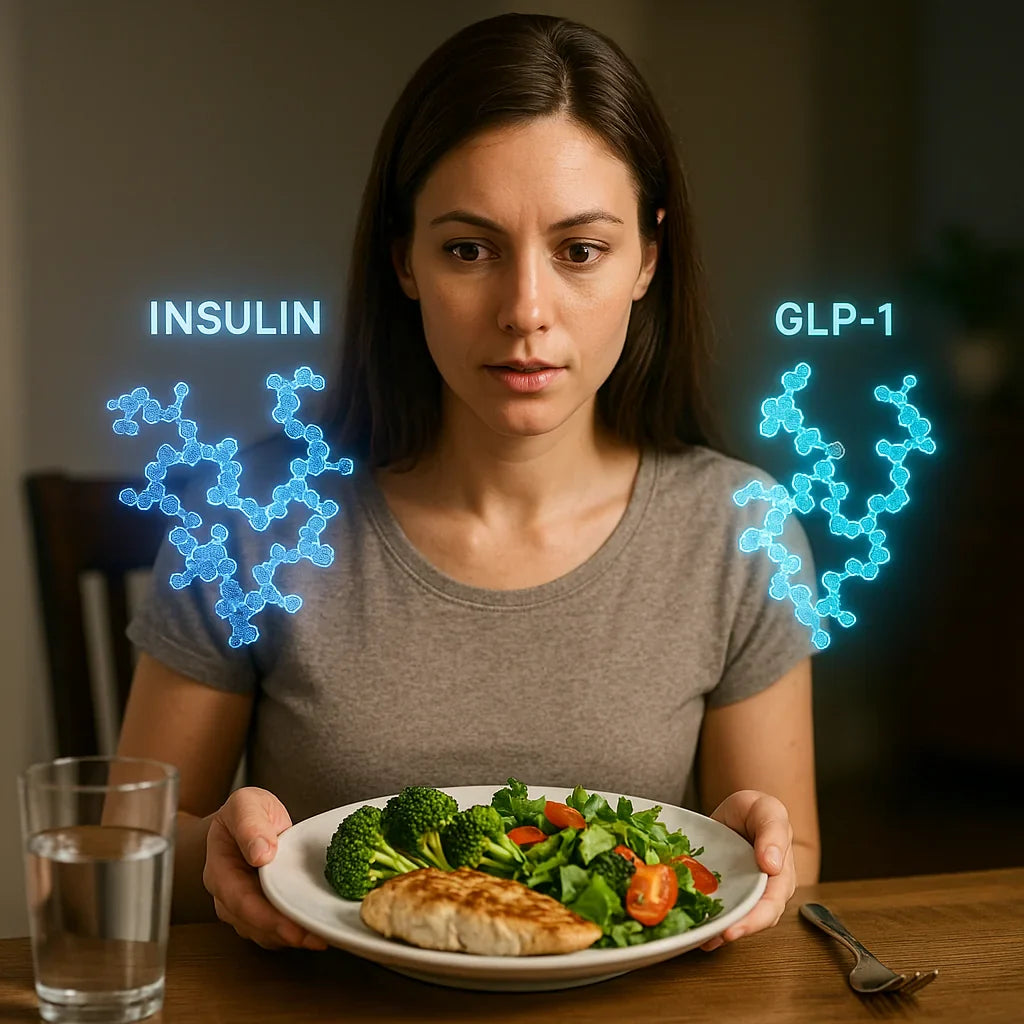Hormones and Weight: How Insulin and GLP-1 Affect Your Metabolism

Stubborn weight gain isn’t just about calories – hormones play a huge role. Get to know two key hormones, insulin and GLP-1, and how they affect your metabolism, appetite, and fat storage (especially for women).
If you’ve ever wondered why what you eat can matter more than how much, the answer usually comes down to hormones. Insulin and GLP-1 are two hormonal heavy-hitters when it comes to weight and metabolism. Understanding their roles can illuminate mysteries like why you crash after a sugary lunch or why that high-protein salad kept you full for hours. Let’s dive into how these hormones work and interact, particularly in women’s bodies.

Insulin: The Fat Storage Switch
Insulin is often dubbed the “storage hormone.” After you eat carbs (or protein to a smaller degree), your blood sugar rises and your pancreas releases insulin. Insulin’s job is to help shuttle that blood sugar into cells (muscles, liver) to be used for energy or stored. When insulin is elevated, your body is in storage mode and not in fat-burning mode. That’s normal and healthy in balance – you eat, you store some energy, then between meals you burn it.
The problem arises with chronically high insulin, known as insulin resistance. Many women, especially with PCOS or those gaining weight around the belly, have insulin levels that stay elevated. This could be due to genetics, diet (too many fast carbs too often), or even stress. High insulin not only makes it hard to lose fat (because the body is constantly told to store, store, store), but insulin itself can increase hunger. It’s a double whammy: you’re hungrier and more calories get stored as fat. Signs of insulin resistance include intense carb cravings, an afternoon energy crash, and difficulty losing weight despite diet/exercise. It’s like the body’s metabolic gears are stuck.
GLP-1: The Appetite Tamer
GLP-1, as we learned, is a hormone that does almost the opposite – it signals “we’ve got enough, stop eating”. It enhances insulin’s release at the right time (when glucose is high) but also tells your brain you’re full and slows your stomach from emptying too fast. In essence, GLP-1 puts the brakes on appetite and excessive food intake. It’s more of a short-term meal-to-meal regulator, whereas insulin has immediate and longer-term roles (immediate glucose management and longer-term fat storage).
So, the balance is clear: Meals that spike insulin too high (think a big slice of cake on an empty stomach) without triggering much GLP-1 might leave you in a hungry fat-storing state soon after. Conversely, meals that provoke GLP-1 (protein, fiber) and don’t overdose on quick sugars keep insulin moderate and satiety high. Understanding this interplay is like having a metabolic remote control.
The Female Factor
Women’s hormones (estrogen, progesterone) interact with insulin and appetite too. For instance, in the luteal phase of the menstrual cycle (post-ovulation, before period), women often experience higher appetite and cravings. This is partly due to higher progesterone and possibly slight insulin resistance in that phase – the body might be priming for a potential pregnancy, conserving energy. Also, women with polycystic ovary syndrome (PCOS) often have elevated insulin levels as a core issue, which contributes to weight gain and difficulty losing weight. This is why treatments for PCOS often focus on improving insulin sensitivity (like the drug metformin or a low-GI diet) – and interestingly, GLP-1-based medications are showing promise in PCOS as well, because they address appetite and improve insulin response.
Menopause is another stage: as estrogen falls, insulin resistance can increase, and fat tends to redistribute to the abdomen. Lower estrogen may also blunt GLP-1 secretion after meals (some studies suggest this, which could be one reason postmenopausal women experience increased appetite or weight gain). Thus, after menopause, paying attention to diet composition to maximize GLP-1 and minimize big insulin spikes becomes even more crucial.
Balancing Act for a Better Metabolism
-
Favor Low-Glycemic, High-Nutrient Foods: These are foods that don’t cause huge insulin spikes and often trigger more GLP-1. Examples: whole grains instead of refined, fruit instead of juice, protein with each meal, plenty of veggies, and healthy fats. This way insulin rises modestly and GLP-1 helps you feel satisfied.
-
Meal Timing and Carb Pairing: If you’re going to enjoy something sugary or starchy, have it with a meal, not by itself. The other components (fiber, protein, fat) slow absorption, meaning less extreme insulin response and more GLP-1 action. A cookie after a balanced lunch is metabolically gentler than a cookie as a 3 pm standalone snack.
-
Stay Active: Muscles used during exercise become more sensitive to insulin (they’ll take up glucose without needing as much insulin). This improved insulin sensitivity means your baseline insulin level comes down – great for fat burning. Activity may also increase GLP-1 secretion; even a single bout of exercise can raise GLP-1 for a short period.
-
Consider Targeted Help: If you know or suspect insulin resistance (e.g., you have acanthosis nigricans – those dark velvety skin patches, or a family history of diabetes), talk to a doctor. Nutritional supplements like chromium or inositol can aid insulin, and as mentioned, berberine has been shown to improve insulin function too. They’re not magic, but part of a plan. Conversely, if you struggle with constant hunger, focusing on GLP-1 strategies (like higher protein, possible GLP-1 boosting supplements) can make a difference.
Knowledge is power. Recognizing that hormones like insulin and GLP-1 are modifiable through lifestyle gives you a sense of control. Instead of blaming yourself for lack of willpower, you start strategizing: “How can I tweak my breakfast to keep insulin happy and GLP-1 robust?” These little changes, grounded in hormone science, snowball into a faster metabolism and easier weight management. At the end of the day, a hormonally balanced body is a healthier, more energetic body. And that is what we aim for with the Beyond GLP-1 approach – optimizing the inner chemistry that ultimately shapes our outer results.







